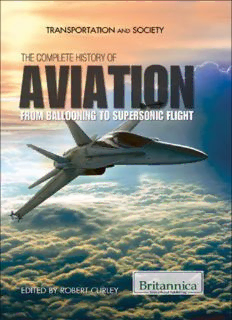
Complete History of Aviation: From Ballooning to Supersonic Flight PDF
Preview Complete History of Aviation: From Ballooning to Supersonic Flight
THE COMPLETE HISTORY OF AVIATION FROM BALLOONING TO SUPERSONIC FLIGHT TRANSPORTATION AND SOCIETY THE COMPLETE HISTORY OF AVIATION FROM BALLOONING TO SUPERSONIC FLIGHT EDITED BY ROBERT CURLEY, MANAGER, SCIENCE AND TECHNOLOGY Published in 2012 by Britannica Educational Publishing (a trademark of Encyclopædia Britannica, Inc.) in association with Rosen Educational Services, LLC 29 East 21st Street, New York, NY 10010. Copyright © 2012 Encyclopædia Britannica, Inc. Britannica, Encyclopædia Britannica, and the Thistle logo are registered trademarks of Encyclopædia Britannica, Inc. All rights reserved. Rosen Educational Services materials copyright © 2012 Rosen Educational Services, LLC. All rights reserved. Distributed exclusively by Rosen Educational Services. For a listing of additional Britannica Educational Publishing titles, call toll free (800) 237-9932. First Edition Britannica Educational Publishing Michael I. Levy: Executive Editor J.E. Luebering: Senior Manager Marilyn L. Barton: Senior Coordinator, Production Control Steven Bosco: Director, Editorial Technologies Lisa S. Braucher: Senior Producer and Data Editor Yvette Charboneau: Senior Copy Editor Kathy Nakamura: Manager, Media Acquisition Robert Curley: Manager, Science and Technology Rosen Educational Services Jeanne Nagle: Senior Editor Nelson Sá: Art Director Cindy Reiman: Photography Manager Karen Huang: Photo Researcher Brian Garvey: Designer Matt Cauli: Cover Design Introduction by Laura Loria Library of Congress Cataloging-in-Publication Data The complete history of aviation: from ballooning to supersonic flight/edited by Robert Curley.—1st ed. p. cm.—(Transportation and society) “In association with Britannica Educational Publishing, Rosen Educational Services.” Includes bibliographical references and index. ISBN 978-1-61530725-8 (eBook) 1. Aeronautics—Juvenile literature. I. Curley, Robert, 1955– TL547.C575 2012 629.13009—dc23 2011018093 On the cover: A jet fighter plane soars above the clouds. Jet-engine fighter planes were used sparingly during World War II, and were refined in the post-war years. Shutterstock.com On page viii: Hot air balloons take flight near Canterbury, Eng., as part of a mass crossing of the English Channel on April 7, 2011. Oli Scarff/Getty Images Pages 1, 18, 36, 52, 82, 104, 123, 145, 156, 158, 161 Shutterstock.com Introduction Chapter 1: Balloon Flight Elements of Balloon Flight The Pioneers The Montgolfier Brothers The Gas-Hot-Air Hybrid Balloon Smoke and Coal Gas Military Experiments and Petroleum Fuel Balloons Reach the Stratosphere Plastic Balloons Superpressure Balloons Modern Hot-Air Balloons Chapter 2: Flight Balloons and Airships Hot-Air Ballooning Hot-Air Balloon Components Envelope Design Deflation Systems Burners Baskets High-Altitude Ballooning Long-Distance Ballooning Steve Fossett Circles the Globe Airships The Hindenburg Disaster Chapter 3: The Invention of the Airplane The Problem of Lift The Problem of Propulsion The Wright Brothers at Kitty Hawk The Problem of Control Other Aviation Pioneers Chapter 4: Pistons and Propellers The Headliners Lindbergh Crosses the Atlantic The First Airlines From Airmail to Airlines in the United States The DC-3 The Aeronautical Infrastructure Wartime Legacies Postwar Airlines General Aviation Chapter 5: The Jet Age First Experiments World War II Technical Advantages and Challenges The Black Box The Airlines Re-equip Progress in Engines and Airframes Air Force One Avionics, Passenger Support, and Safety Supersonic Flight The Concorde Chapter 6: Helicopters, Hang Gliders, and Ultralights The Helicopter History Autogiros Principles of Flight and Operation Control Functions The Hang Glider Otto Lilienthal The Ultralight Chapter 7: Airports Modern Airports Operational Requirements Runway Configurations Runway Pavements Navigational Aids, Lighting, and Marking
Description: